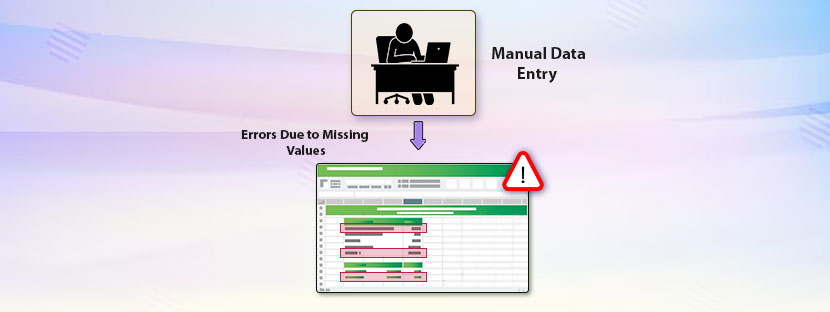In This Article
Maintaining accuracy in the data entry process is the most essential task in this competitive digital era. One mistake, just one mistake, in data entry, can cost millions to companies. Therefore, companies always apply different tricks and tips to resolve manual data entry errors and avoid any losses.
However, the task of robust data entry has become more complex at this present moment because of digital integration. Businesses are now acquiring huge quantities of data to find new scopes. With this, the data entry specialists now have to handle data in gigantic volumes regularly. Therefore, mistakes while keeping records become common in this process but businesses are focusing on minimizing this.
Besides manual data entry, data entry automation systems are also there to handle data entry tasks. However, these systems lack human insights to perform crucial data entry tasks. Thus, companies majorly rely on manual processes at the final stage to check the accuracy of the data. Outsourcing Manual Data Entry Services is very common for this reason.
In this piece, you will find a detailed answer to resolve manual data entry errors along with some practical tips. This blog also aims to cover the common mistakes of the data entry processes in a comprehensive format.
Let’s start this with an explanation of why manual data entry, why not automated.
A. Why do Companies Still Prefer Manual Data Entry?
Being present in the era of digital technology, trusting the manual data entry tasks is not a setback for companies. Rather, companies nowadays prefer to implement manual data entry systems in the operation for numerous reasons. Previously, manual data entry was part of small companies because they often lacked funds to adopt data entry automation.
However, big companies nowadays heavily rely on manual processes to ensure the safety of their crucial database. Keeping the process of recording data manually can minimize the risks of cyber attacks. Besides that, companies can save costs by not deploying automated software to manage data entry accuracy.
However, deploying the manual process at the final stage as a strategy also brings positive results. For that, companies need to resolve manual data entry errors first with the best practices. Usually, companies handle sensitive data through a manual process hence resolving errors is necessary here. However, the manual process also contains various risky elements, which are described next.
B. Risks Associated with Manual Data Entry
Handling data entry tasks through manual inspection will always include risk elements. As an example of a data entry mistake, the government of Virginia had to pay double for mailing absentee applications to 500,000 voters mistakenly. It happened due to a clerical mistake as someone incorrectly mixed up different spreadsheets together.
Well, this is not only a single example of a manual entry mistake, there are many more like this. The main concern here is the effects on brand reputation and profitability. With one single manual entry mistake, businesses can lose millions of profits. However, mistakes do not always happen from one end as many things are also there. It also happens in data entry automation processes.
For instance, if companies do not hire skilled data entry professionals then mistakes will become very frequent in the process. However, businesses can resolve manual data entry errors with effective measures. But before jumping on the measures, first, let’s understand the common types of mistakes that appear frequently.
C. 5 Common Manual Data Entry Process Errors
The tasks of data entry seem simple but they consume a lot of time. The data entry specialists need to have patience while handling these tasks. However, still maintaining proper care, mistakes can appear in the process. All these mistakes have a common pattern and thus you need to understand this pattern to avoid them. Here is the list of common mistakes in manual data entry presented before you.
1. Errors While Handling Ambiguous Data
The same data may have different variations and also can represent different values. For instance, data entry accuracy specialists would record all dates in MM-DD-YYYY format for US business. On the other hand, the same date would be written in the DD-MM-YYYY format of European businesses. In both cases, the data is accurate but the format is different so it creates an ambiguity while recording.
The problem would appear in contrast while validating ambiguous data. How a data validator would resolve manual data entry errors if the data is ambiguous? Concerning the example, the validator may think the US representation is appropriate or maybe the European representation. Therefore, a system with a specific format can solve this issue of ambiguity easily.
2. Errors Due to Missing Values
What do you think about blank fields that appear in your database? Blank fields do not represent inaccuracy but can cause mistakes in deriving results. Besides that, black fields sometimes create negative impressions. Suppose you leave space in the field where you have to put your school details while applying for college forms. What does that black space represent in your form?
Simply, it represents that you did not attend any school thus it will lead to the rejection of your application. Hence, you observed here the value of blank fields that can change the meaning of the data completely. Leaving blank fields is a common mistake and it can create inaccuracy in the database.
3. Errors Due to Inconsistency
Incomplete or inconsistent data can create major errors in the system and it seems apparent in manual entries. Inconsistent data cannot represent direct error but it can create many errors. Therefore, you need to resolve manual data entry errors, especially inconsistency errors.
To understand inconsistency error, let’s focus on this example. Suppose your database has two datasets named; “Data Entry” and “data entry”. Both the datasets are right but you cannot take them because of inconsistency errors. Sometimes inconsistent data generates duplicate values hence you have to keep checking them throughout.
4. Errors Because of Invalid Values
Imagine a database where the data entry specialist by mistake has put the contact number in the place of the email address. On the other hand, despite the email list, you have a list of contact numbers. Is the data entry accuracy operation right here? Not at all, it is an example of invalid values where you cannot do anything with the value. Hence, validity checking is a crucial part of making the database relevant and correct.
5. Errors Due to Updates
Companies frequently update the database as per their current requirements. With the update, the entire database gets new formats along with different patterns. Errors are very frequent while transporting the data from one pattern to another. A system to resolve manual data entry errors is very essential at this stage. Otherwise, the data will keep causing errors in the file and make results unworthy.
Eliminating errors is the prime element of the manual data entry process. With the accurate implementation of the right techniques, you can also do that. For your help, some of the best error-elimination tips are analyzed below.
D. The 8 Excellent Tips on How to Reduce Data Entry Error Rate
1. Always Hire Skilled Staff
Skilled labor is the backbone of efficient and robust data entry practices in an organization. Therefore, you need to hire skilled employees in your organization to manage your data entry tasks. However, only hiring skilled employees is not sufficient as you need to provide them with proper training. Besides that, you need to provide them with ample chance to upgrade their skills.
Suppose you have hired skilled staff at your organization but you allocate them the huge burden of work. So, how would they perform? Despite having proper knowledge of the work, they will still make silly mistakes, probably the common mistakes. To resolve manual data entry errors, therefore, you need to initiate a different process further. That will cost more and the productivity of your skilled workers will decrease simultaneously.
Hence, outsourcing the manual and automating data entry tasks is the best way to handle this work. With the help of skilled workers, you can efficiently manage all your work within time.
2. Double Check Everything
The best way to tackle data entry mistakes is to initiate a double-checking process. Besides a standard checking process, a double-checking process will decrease the chance of causing errors. Many companies have integrated the double-checking process into the standard checking process. Hence, it gives them a chance to correct what they have mistakenly entered in the database.
Re-entering data is a daunting task and can harm an organization’s overall productivity. However, with the help of a double-checking process, you can easily eliminate the need to re-enter the data. Therefore, the process will easily increase the overall productivity of the organization.
3. Update on Time
Besides entering the data, you need to keep your databases updated on time. By updating the database on time, you can resolve manual data entry errors by manifolds. Sometimes the system holds the wrong data because it was not updated on time. That not only damages the quality of the data but also damages organizations financially.
Nowadays, organizations keep automated data entry systems to record manually entered data. Remember that, automated systems are highly prone to getting cyber threats and attacks. However, with timely updates, automated systems get safeguards against all kinds of cyber threats. Besides that, updating the database on time will also make its functioning smooth and operative.
4. Set Goals
To improve data accuracy, setting up realistic goals are must. Setting goals not only reduce data entry errors but also keeps the data entry process on track. Organizations usually create goals to record the performance of certain elements. With the application of the same tactic, you can set goals to check the performance of your data entry processes.
5. Find Sources of Inaccuracy
Data inaccuracy in the manual data entry process is a quite common and very general thing. However, to resolve manual data entry errors, you need to find its sources first. Errors or inaccuracies can be caused by internal sources or external sources. Finding the sources will help you to track the errors and frame strategies to eliminate them.
Finding the sources of inaccuracy will help you to fix the error quickly and efficiently. Identifying the internal sources of inaccuracy is easy as it involves only the errors from the data entry specialist’s side. However, identifying the external sources of inaccuracy is quite challenging in this case.
With the best strategies for automating data entry, you can find the internal as well as external sources and then easily fix them. Besides, you can reduce the time of checking the database from start to last if you know the source. In gist, you can fix any type of error on time once you know the sources very well.
6. Consider Automated Data Entry System
Some organizations have installed software to manage the robust data entry tasks while some rely on manual recording. However, having software for this process helps organizations generate automated reports. To resolve manual data entry errors, these reports help a lot. These reports are nothing but reminders that something in the file is wrong. Therefore, the data entry operator can make changes accordingly to reduce data entry errors.
7. Set Accuracy Standards
Setting standards is the most effective way you can eliminate the data entry mistakes within time. You can set accuracy standards for everything be it data recording, validation, linking, or any other tasks. Setting accuracy standards will work as a guideline to follow for managing the data entry work.
Your data entry workers can follow the set accuracy standard in all your data entry processes thoroughly. This will not only bring efficiency to the system but also keep the process in check. With set standards, you can resolve manual data entry errors easily and accurately. Also, you can implement this strategy in automated data entry procedures.
8. Choose Outsourcing
Outsourcing is an effective solution to minimize data entry mistakes from scratch. Because you do not have to do anything from your side, all your data entry needs will be accomplished by outsourcers. However, choosing the right partner is essentially important when you prefer to outsource manual and automating data entry tasks.
The outsourcing agency will resolve manual data entry errors if occur by any chance. All you need to do is check the standard of your outsourcing agency before the deal. To this date, outsourcing has done amazing work in the field of data entry. Hence, you can rely on outsourcing for all your manual data entry needs and to reduce data entry errors.











